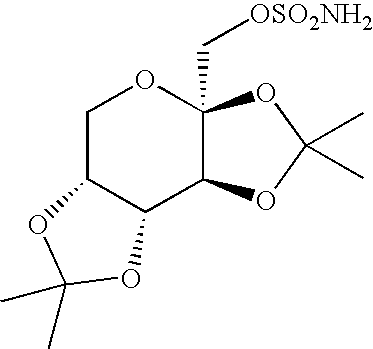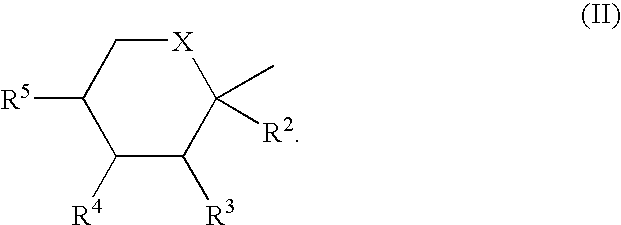Process for the preparation of sulfamate derivatives
a technology of sulfamate and derivatives, which is applied in the field of process for the preparation of sulfamate derivatives, can solve the problems of difficult recycling of methylene chloride as a solvent, relatively low yield of desired compound, and high cost of ether solvents
- Summary
- Abstract
- Description
- Claims
- Application Information
AI Technical Summary
Benefits of technology
Problems solved by technology
Method used
Image
Examples
example 1
Preparation of Starting Material: 2,3:4,5-Bis-O-(1-methylethylidene)-β-D-fructopyranose
[0035] Into a 20 L 4-necked round bottom flask, acetone (10 L) and fructose (1 kg) were added at a temperature of about 25° C. under stirring. The reaction mass was cooled to 0° C. and concentrated sulfuric acid (600 ml) was added to the reaction mixture. After completion of addition of concentrated sulfuric acid the reaction mixture was maintained at a temperature of about 25° C. under stirring for between 3 to 4 hours. The progress of the reaction was monitored by TLC. After completion of the reaction as determined by TLC, a 50% NaOH solution (4 L) was added in portions at a temperature of about 10° C. over about 30 minutes. The precipitated solids were filtered and the salt cake was washed with acetone (500 ml). The filtrate and washings were combined and then distilled under a vacuum below a temperature of about 65° C., until no more drops were observed. Isopropanol (300 ml) was added to the ...
example 2
Preparation of Starting Material: 2,3:4,5-Bis-O-(1-methylethylidene)-β-D-fructopyranose
[0040] Into a 5.0 L 4-necked round bottom flask, acetone (2.0 L) and D-fructose (200.0 g) were added at a temperature of about 25° C. under stirring. The reaction mass was cooled to −5 to 0° C. and concentrated sulfuric acid (120.0 ml) was added to the reaction mixture. After completion of addition of concentrated sulfuric acid the reaction mixture was maintained at a temperature of about 25-30° C. under stirring for between 3 to 4 hours. The progress of the reaction was monitored by TLC. After completion of the reaction as determined by TLC, the reaction mass was cooled to −5 to 0° C., and 50% NaOH solution (400 gm NaOH in 400 ml water) was added in portions at a temperature of about 10° C. over about 30 minutes. The precipitated solids were filtered and the salt cake was washed with acetone (400 ml). The filtrate and washings were combined and then distilled under a vacuum below a temperature o...
PUM
| Property | Measurement | Unit |
|---|---|---|
| temperature | aaaaa | aaaaa |
| temperature | aaaaa | aaaaa |
| temperature | aaaaa | aaaaa |
Abstract
Description
Claims
Application Information
 Login to View More
Login to View More - R&D
- Intellectual Property
- Life Sciences
- Materials
- Tech Scout
- Unparalleled Data Quality
- Higher Quality Content
- 60% Fewer Hallucinations
Browse by: Latest US Patents, China's latest patents, Technical Efficacy Thesaurus, Application Domain, Technology Topic, Popular Technical Reports.
© 2025 PatSnap. All rights reserved.Legal|Privacy policy|Modern Slavery Act Transparency Statement|Sitemap|About US| Contact US: help@patsnap.com



